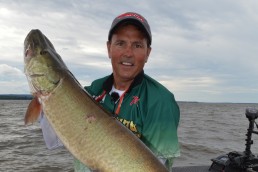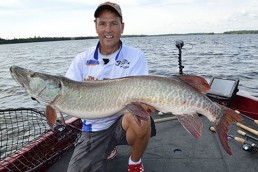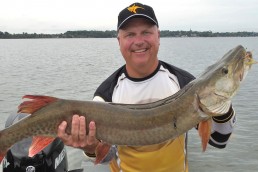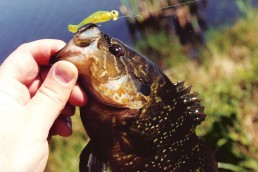SHARE THIS POST
Summer pattern fishing
Despite the winter that would never end, “real” muskie fishing is finally upon us. Summer school is now in session. With the onset of summer, depending upon where you live throughout the muskie range, you could be facing the opening of the muskie season or have been muskie fishing for months. It could feel like late spring, early summer or even mid-summer. As water temperatures warm and the entire ecosystem ramps up on your favorite waters, the muskies locational choices and forage preferences change. Muskies are developing their summer home ranges and are becoming more predictable, but that doesn’t necessarily make them easier to catch. Long summer days give you more time to fish and determine the most productive patterns, but you still need an arsenal of weapons to help you succeed.
We all have a bunch of new lures we purchased during the winter and are all set to try them to trick summer muskies into biting. However, don’t fall into the “lure” trap. Catching summer muskies isn’t all about lures. Your success is more likely dependent upon the ability to recognize and capitalize on the daily summer pattern. Use your lures as tools, but primarily use your brain to figure out what it takes to get a muskie to bite.
Identifying a pattern
A pattern simply is all of the factors that combine to generate a strike from a muskie. In my mind, one muskie bite sets the pattern and I try and replicate everything that produced that bite. Focus on where the muskies are located, what types of cover are they using, and what lure triggered the strike.
In early summer, you find muskies relating to shallow cover and suspended in open water. You might be fishing a small in-line spinner over a shallow flat or casting a magnum soft plastic over the basin. Likewise, the fish may be scattered and you’ll need to troll to maximize your opportunities. To determine the pattern, you’ll need to keep an open mind and seek to answer the question, “What does it take to get a bite?”
Are you enjoying this post?
You can be among the first to get the latest info on where to go, what to use and how to use it!
Exploiting a pattern
Don’t worry about why the muskies utilize a type of structural element or cover as much as identify it, accept it and replicate it. That’s the key to catching muskies. Live in the moment. Simply determine where the muskies are, and what it takes to get them to bite. Remember that getting follows provides valuable data on where the muskies live. A follow can guide you to similar spots to fish, too. However, it also tells you that the lure the muskie followed may or may not be the best choice. Experiment with speed as well as lure choice and color to generate a bite. It’s a straightforward approach to muskie fishing that can break it down and keep you focused.
While fishing, communicate with your partner about what you both believe is happening. For example, if you have had follows from two muskies that were relating to weed points, you should fish more weed points. Rather than fishing other structural elements if you just had two muskie follows, go fish other weed points, regardless of what other spots you know on the lake. Focus your discussion on what lures either triggered a strike or follow and brainstorm together on what lures you should try and possibly how to best adjust speeds.
Angling for follows
Since muskies are curious by nature, it seems that getting a few follows can clue you in to where they live, but getting them to bite is another story. That’s where all of your new lures can help. Keep switching lures, speeds and colors until the followers turn into biters. Then make sure one angler keeps throwing the hot lure while the other experiments. Switching lures is extremely important if the muskies suddenly appear active, as it increases your chances of finding a second hot lure.
To maximize your summer muskie fishing success focus your efforts on determining the daily pattern and working as a team with your boat partner. You’ll be surprised how much faster you can locate and catch muskies.
If you want to learn even more about muskie fishing be sure to check Musky Hunter magazine or muskyhunter.com. Also, watch “The Musky Hunter” television show—pure muskie fishing from the comfort of your own home at muskyhuntertv.com.
MWO
SHARE THIS POST
Did you enjoy this post?
You can be among the first to get the latest info on where to go, what to use and how to use it!
Jim Saric
Jim Saric is a Legendary Angler in the Freshwater Fishing Hall of Fame, the host and executive producer of The Musky Hunter television series, editor at large of Musky Hunter magazine, a seven-time muskie tournament winner, and a contributing writer for numerous other publications.



